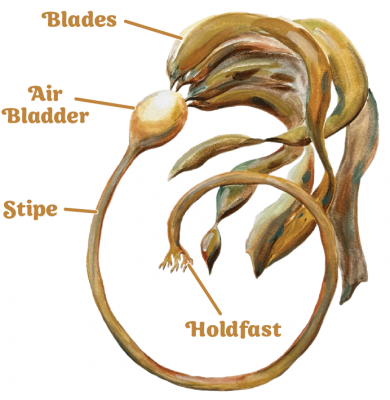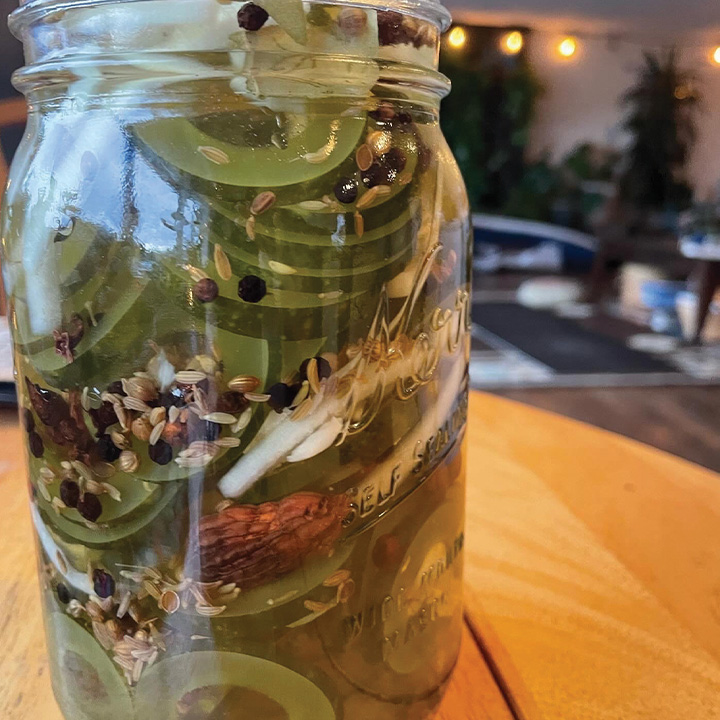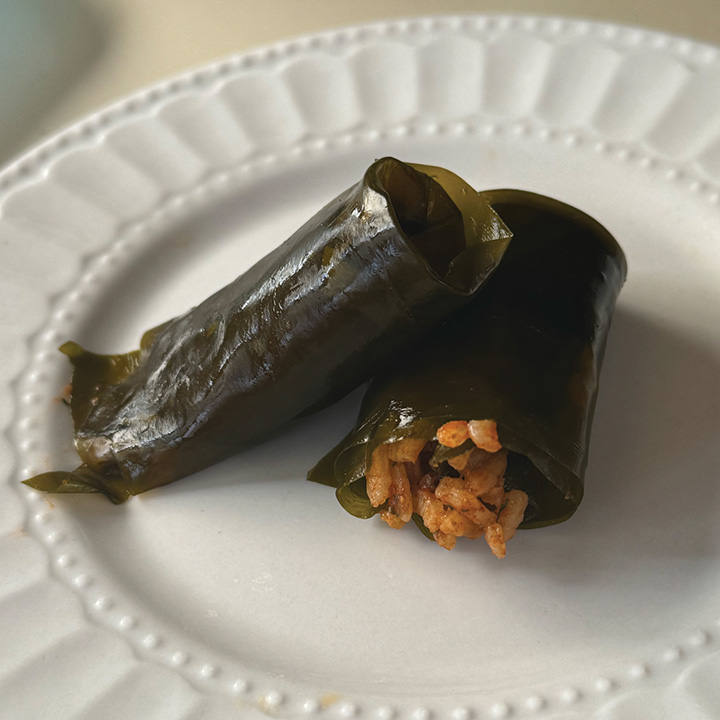
Profile
Bull Kelp (Nereocystis luetkeana)
Bull kelp, whose scientific name aptly translates to “mermaid's bladder,” grows in dense forests, often reaching 100 feet and growing up to two feet per day in warmer months. Found from Alaska to central California, it features a natural anchor called a “holdfast” to attach to rocks, a long hollow stipe, and a gas-filled bladder from which blades grow, forming the iconic kelp forest canopy.
For Pacific Northwest indigenous cultures, bull kelp is more than a seaweed – it's a vital link between land and sea, human and supernatural. Historically, it was used for fishing, hunting, food preparation, and household items like ropes, baskets, and storage containers. Bull kelp is also featured in myths, stories, and children's games, reflecting its cultural importance and the interdependence between indigenous peoples and the sea.
Since 2013, 90% of California's bull kelp forests have disappeared due to warming ocean temperatures and an overabundance of kelp grazers like urchins. Further north in Washington and Alaska, bull kelp forests are healthy and thriving. Farming bull kelp helps reduce harvest pressure on wild kelp forests and provides opportunities for reforestation of this ocean majesty.
 Flavor Profile (notes and cooking tips)
Flavor Profile (notes and cooking tips)
Clean, vegetal, and umami
Texture
Blades are tender, al dente, sticky, with a slight crunch. Stipe is thick and crunchy - similar to raw carrots
Preparation Tips
The blades, stipe, and air bladder of bull kelp have distinct textures, densities and cook times so it's best to separate them using a sharp kitchen knife.
Where is it Farmed?
Ocean-based farms in California and Alaska
Harvest Season
Summer & early fall
Nutrition
Rich in calcium, magnesium, sodium, iodine, potassium, bromine, phosphorus, iron, bulk fiber, vitamins A, B complex, C, D, E, and K.
Storage Tips
Separate stipe & blades before storing. Refrigerate and consume within 5 days of harvest. To prolong shelf life, freeze or dry in dehydrator and store
in a cool, dry place.
Environmental Benefits
Absorbs CO2 from the ocean and produces oxygen, shelters many commercially important fish, sea otters and invertebrates, and protects coastlines from erosion.
Recipes

Bull Kelp Pickles
Recipe by Shifting Tides
Ingredients
Equipment needed: 32 oz mason jar or multiple smaller jars
- 1" - 12" stipe of bull kelp
- 2/3 cup water
- 2 cups white vinegar
- 2 tsp sugar
- 4 tbsp pickling spice (or mix of mustard seed, celery seed, bay leaves, star anise, etc)
- 4 bay leaves
- 1 small onion
- 4 garlic cloves
- lemon juice
Directions
- Sterilize jars by boiling in hot water for 1 minute
- Rinse bull kelp stipe in cold fresh water.
- Peel the “skin” off the bull kelp stipe using a potato peeler.
- Cut stipe and onion into ¼” rings, cut onion rings in half
- Combine kelp rings and onion in a bowl, sprinkle with salt and mix together to draw out liquid, add ice and mix again, keep in bowl while processing the rest of the steps, up to 3 hours, depending on desired crispiness
- Combine pickling brine- water, vinegar, sugar, spices- in a pot and bring to a boil for one minute.
- Rinse salt soaked kelp and onions in freshwater and tightly pack into jar.
- Pour hot pickling brine over top of the kelp and onion, cover with a sterile lid.
- Refrigerate for at least 48 hours before serving.

Bull Kelp Dolma
Recipe by Jules Marsh, Kelpful
Ingredients
- 1 tbsp olive oil
- 1 sweet yellow onion - finely diced
- 2 tbsp chopped mushrooms (optional, shiitake recommended)
- 1 cup white rice,
- 2 tbsp tomato paste,
- 2 tbsp dried currants (soaked for 20-30 mins & drained)
- 2 tbsp pine nuts
- 1 tbsp dried mint
- 1 tbsp dried dill weed
- 1 tsp ground allspice
- 1 tsp ground cumin
- 15-20 blades of fresh or rehydrated bull kelp - cut to ~6” length
Directions
- Prepare 1 cup of white rice al dente (~3-5 minutes less than fully cooked, you’ll be steaming this filling wrapped inside the Bull Kelp later).
- Saute onion in olive oil until translucent.
- Add chopped mushrooms and saute until fully cooked and golden brown.
- Add al dente rice, tomato paste, currants, pine nuts, and seasoning and mix to combine.
- Lay blade of Bull Kelp out and add tbsp of rice mixture in center. Fold the sides over and roll like a cigar. Repeat until all filling and kelp blades have been used. The kelp will be slimy the longer you work with it, and rolling takes some practice and patience!
- Prepare a pot with a steamer basket, place rolled dolma pieces inside and add water until bottom layer is just covered. Cover the pot and steam until bull kelp turns a vibrant bright green and rice is fully cooked (~3-5 mins). Remove from the steamer and serve.